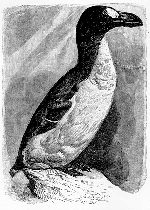

Auks are a common group of marine birds comprising 22 species, and include guillemots and puffins. The largest species, the Great Auk, became extinct in 1844. Auks are weak fliers, (the Great Auk was completely flightless), but excellent underwater swimmers. When submerged, they propel themselves with their wings, steering with the feet. The legs are near the tail, giving the birds an upright posture on land, like that of a penguin. Living auks weigh from 90 grams to 1 kg. The Great Auk weighed 5 kg.
Auks apparently originated near the Bering Sea, and presently occur in the North Pacific, North Atlantic, and Arctic Oceans. The Great Auk inhabited temperate and subarctic waters (Northern Britain, Iceland, Greenland, and Newfoundland), moving further south in winter. Except during the breeding season, auks live in the open sea.
The diet of auks consists principally of fish, but also includes many other types of marine organisms. Most auk species breed in large colonies, choosing coastal cliff ledges, crevices, and burrows for their nests. Males and females share the task of incubating the one or two eggs, a process which requires four to six weeks. Depending on the species, the chicks remain in the nest for a period of two to fifty days.